Namoi Cotton's Strategic Management: Market and Competitor Analysis
VerifiedAdded on 2022/10/17
|7
|1418
|10
Report
AI Summary
This report provides a comprehensive strategic management analysis of Namoi Cotton, focusing on its market position and competitive landscape. It begins with an overview of the organization, established in 1962 and restructured in 2017, and then delves into competitor analysis, identifying key rivals like LDC Enterprises Australia Pty Limited and Olam Investment Australia Pty Ltd. The report highlights Namoi Cotton's market share and the importance of understanding competitor actions and resource similarities. It also discusses the drivers of competitive behavior, including motivation, awareness, and ability, and analyzes the impact of these factors on Namoi Cotton's strategies. Furthermore, the report applies Porter's Five Forces framework to assess the threats and opportunities within the cotton industry, including the threat of new entrants, bargaining power of suppliers and buyers, the threat of substitutes, and rivalry among existing competitors. The analysis emphasizes the need for Namoi Cotton to innovate and maintain a competitive edge in the market.
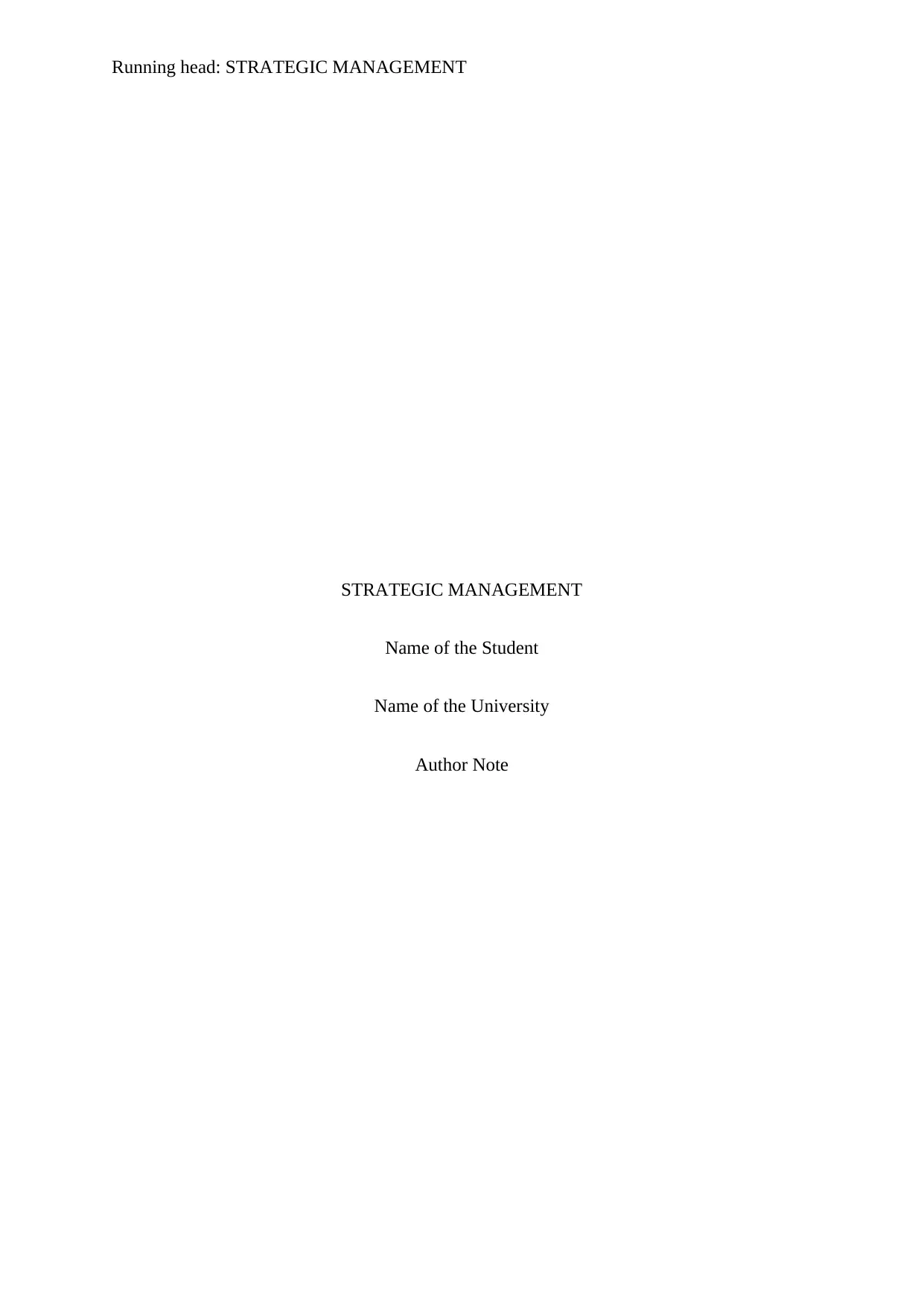
Running head: STRATEGIC MANAGEMENT
STRATEGIC MANAGEMENT
Name of the Student
Name of the University
Author Note
STRATEGIC MANAGEMENT
Name of the Student
Name of the University
Author Note
Paraphrase This Document
Need a fresh take? Get an instant paraphrase of this document with our AI Paraphraser
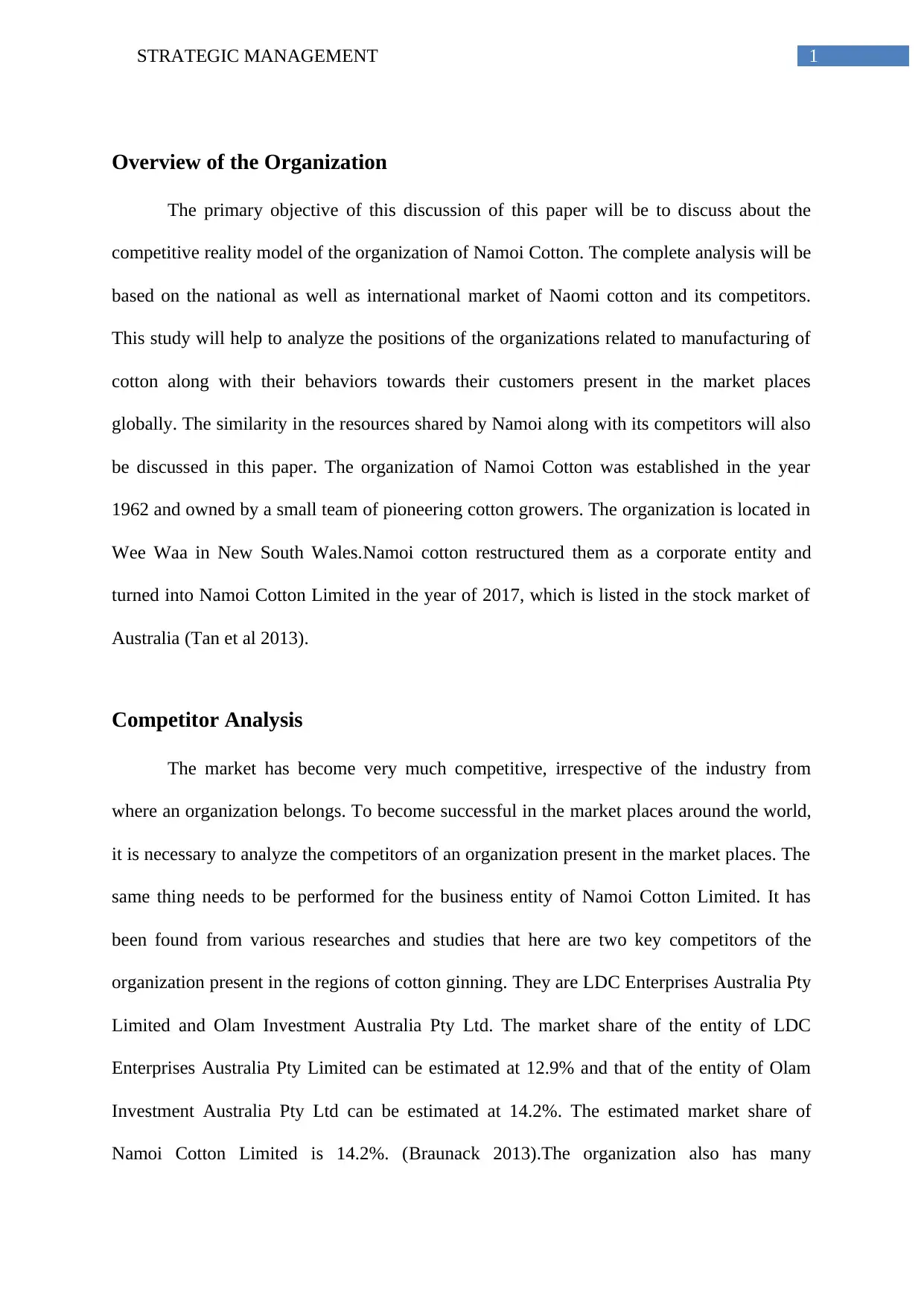
1STRATEGIC MANAGEMENT
Overview of the Organization
The primary objective of this discussion of this paper will be to discuss about the
competitive reality model of the organization of Namoi Cotton. The complete analysis will be
based on the national as well as international market of Naomi cotton and its competitors.
This study will help to analyze the positions of the organizations related to manufacturing of
cotton along with their behaviors towards their customers present in the market places
globally. The similarity in the resources shared by Namoi along with its competitors will also
be discussed in this paper. The organization of Namoi Cotton was established in the year
1962 and owned by a small team of pioneering cotton growers. The organization is located in
Wee Waa in New South Wales.Namoi cotton restructured them as a corporate entity and
turned into Namoi Cotton Limited in the year of 2017, which is listed in the stock market of
Australia (Tan et al 2013).
Competitor Analysis
The market has become very much competitive, irrespective of the industry from
where an organization belongs. To become successful in the market places around the world,
it is necessary to analyze the competitors of an organization present in the market places. The
same thing needs to be performed for the business entity of Namoi Cotton Limited. It has
been found from various researches and studies that here are two key competitors of the
organization present in the regions of cotton ginning. They are LDC Enterprises Australia Pty
Limited and Olam Investment Australia Pty Ltd. The market share of the entity of LDC
Enterprises Australia Pty Limited can be estimated at 12.9% and that of the entity of Olam
Investment Australia Pty Ltd can be estimated at 14.2%. The estimated market share of
Namoi Cotton Limited is 14.2%. (Braunack 2013).The organization also has many
Overview of the Organization
The primary objective of this discussion of this paper will be to discuss about the
competitive reality model of the organization of Namoi Cotton. The complete analysis will be
based on the national as well as international market of Naomi cotton and its competitors.
This study will help to analyze the positions of the organizations related to manufacturing of
cotton along with their behaviors towards their customers present in the market places
globally. The similarity in the resources shared by Namoi along with its competitors will also
be discussed in this paper. The organization of Namoi Cotton was established in the year
1962 and owned by a small team of pioneering cotton growers. The organization is located in
Wee Waa in New South Wales.Namoi cotton restructured them as a corporate entity and
turned into Namoi Cotton Limited in the year of 2017, which is listed in the stock market of
Australia (Tan et al 2013).
Competitor Analysis
The market has become very much competitive, irrespective of the industry from
where an organization belongs. To become successful in the market places around the world,
it is necessary to analyze the competitors of an organization present in the market places. The
same thing needs to be performed for the business entity of Namoi Cotton Limited. It has
been found from various researches and studies that here are two key competitors of the
organization present in the regions of cotton ginning. They are LDC Enterprises Australia Pty
Limited and Olam Investment Australia Pty Ltd. The market share of the entity of LDC
Enterprises Australia Pty Limited can be estimated at 12.9% and that of the entity of Olam
Investment Australia Pty Ltd can be estimated at 14.2%. The estimated market share of
Namoi Cotton Limited is 14.2%. (Braunack 2013).The organization also has many
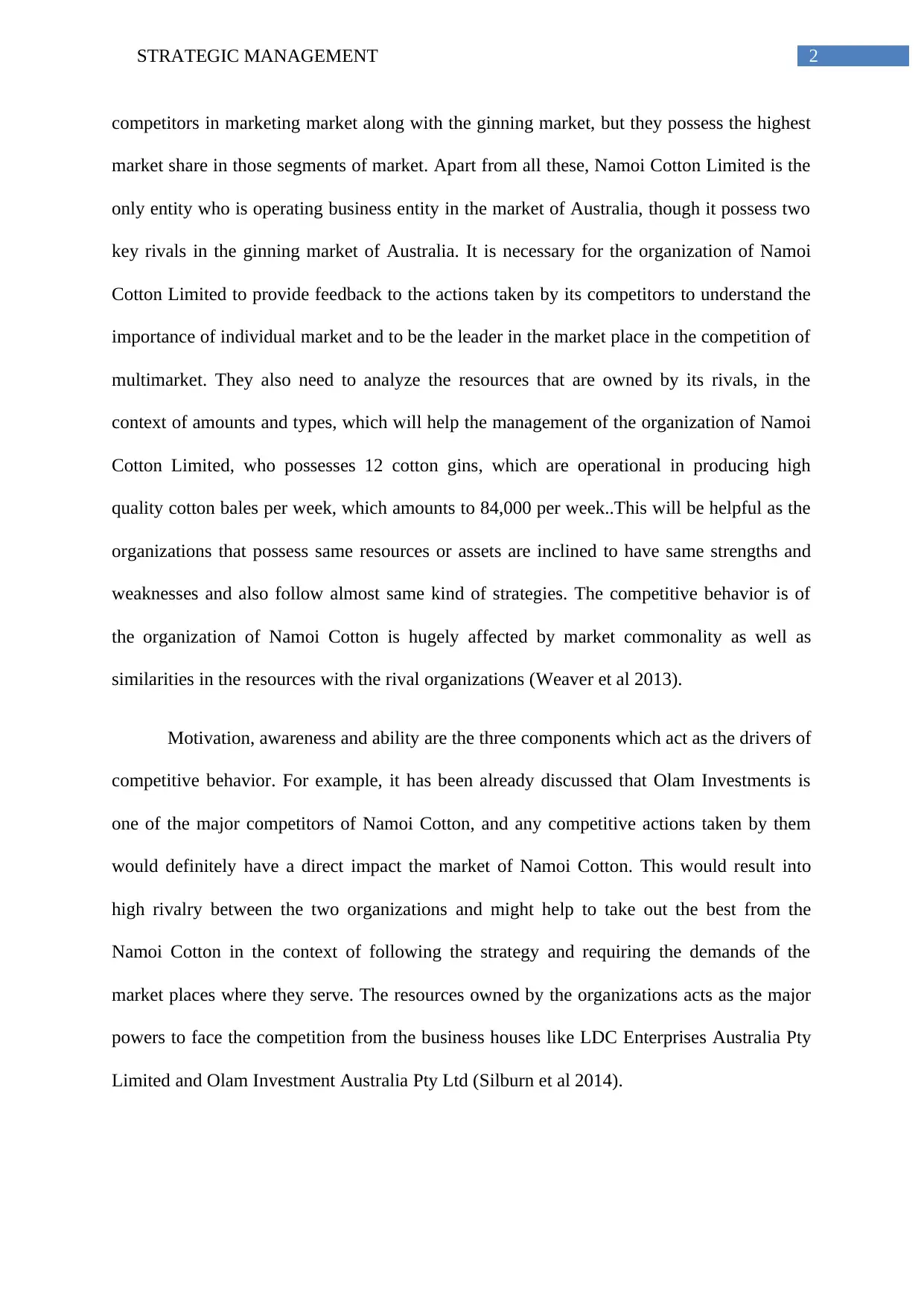
2STRATEGIC MANAGEMENT
competitors in marketing market along with the ginning market, but they possess the highest
market share in those segments of market. Apart from all these, Namoi Cotton Limited is the
only entity who is operating business entity in the market of Australia, though it possess two
key rivals in the ginning market of Australia. It is necessary for the organization of Namoi
Cotton Limited to provide feedback to the actions taken by its competitors to understand the
importance of individual market and to be the leader in the market place in the competition of
multimarket. They also need to analyze the resources that are owned by its rivals, in the
context of amounts and types, which will help the management of the organization of Namoi
Cotton Limited, who possesses 12 cotton gins, which are operational in producing high
quality cotton bales per week, which amounts to 84,000 per week..This will be helpful as the
organizations that possess same resources or assets are inclined to have same strengths and
weaknesses and also follow almost same kind of strategies. The competitive behavior is of
the organization of Namoi Cotton is hugely affected by market commonality as well as
similarities in the resources with the rival organizations (Weaver et al 2013).
Motivation, awareness and ability are the three components which act as the drivers of
competitive behavior. For example, it has been already discussed that Olam Investments is
one of the major competitors of Namoi Cotton, and any competitive actions taken by them
would definitely have a direct impact the market of Namoi Cotton. This would result into
high rivalry between the two organizations and might help to take out the best from the
Namoi Cotton in the context of following the strategy and requiring the demands of the
market places where they serve. The resources owned by the organizations acts as the major
powers to face the competition from the business houses like LDC Enterprises Australia Pty
Limited and Olam Investment Australia Pty Ltd (Silburn et al 2014).
competitors in marketing market along with the ginning market, but they possess the highest
market share in those segments of market. Apart from all these, Namoi Cotton Limited is the
only entity who is operating business entity in the market of Australia, though it possess two
key rivals in the ginning market of Australia. It is necessary for the organization of Namoi
Cotton Limited to provide feedback to the actions taken by its competitors to understand the
importance of individual market and to be the leader in the market place in the competition of
multimarket. They also need to analyze the resources that are owned by its rivals, in the
context of amounts and types, which will help the management of the organization of Namoi
Cotton Limited, who possesses 12 cotton gins, which are operational in producing high
quality cotton bales per week, which amounts to 84,000 per week..This will be helpful as the
organizations that possess same resources or assets are inclined to have same strengths and
weaknesses and also follow almost same kind of strategies. The competitive behavior is of
the organization of Namoi Cotton is hugely affected by market commonality as well as
similarities in the resources with the rival organizations (Weaver et al 2013).
Motivation, awareness and ability are the three components which act as the drivers of
competitive behavior. For example, it has been already discussed that Olam Investments is
one of the major competitors of Namoi Cotton, and any competitive actions taken by them
would definitely have a direct impact the market of Namoi Cotton. This would result into
high rivalry between the two organizations and might help to take out the best from the
Namoi Cotton in the context of following the strategy and requiring the demands of the
market places where they serve. The resources owned by the organizations acts as the major
powers to face the competition from the business houses like LDC Enterprises Australia Pty
Limited and Olam Investment Australia Pty Ltd (Silburn et al 2014).
⊘ This is a preview!⊘
Do you want full access?
Subscribe today to unlock all pages.

Trusted by 1+ million students worldwide
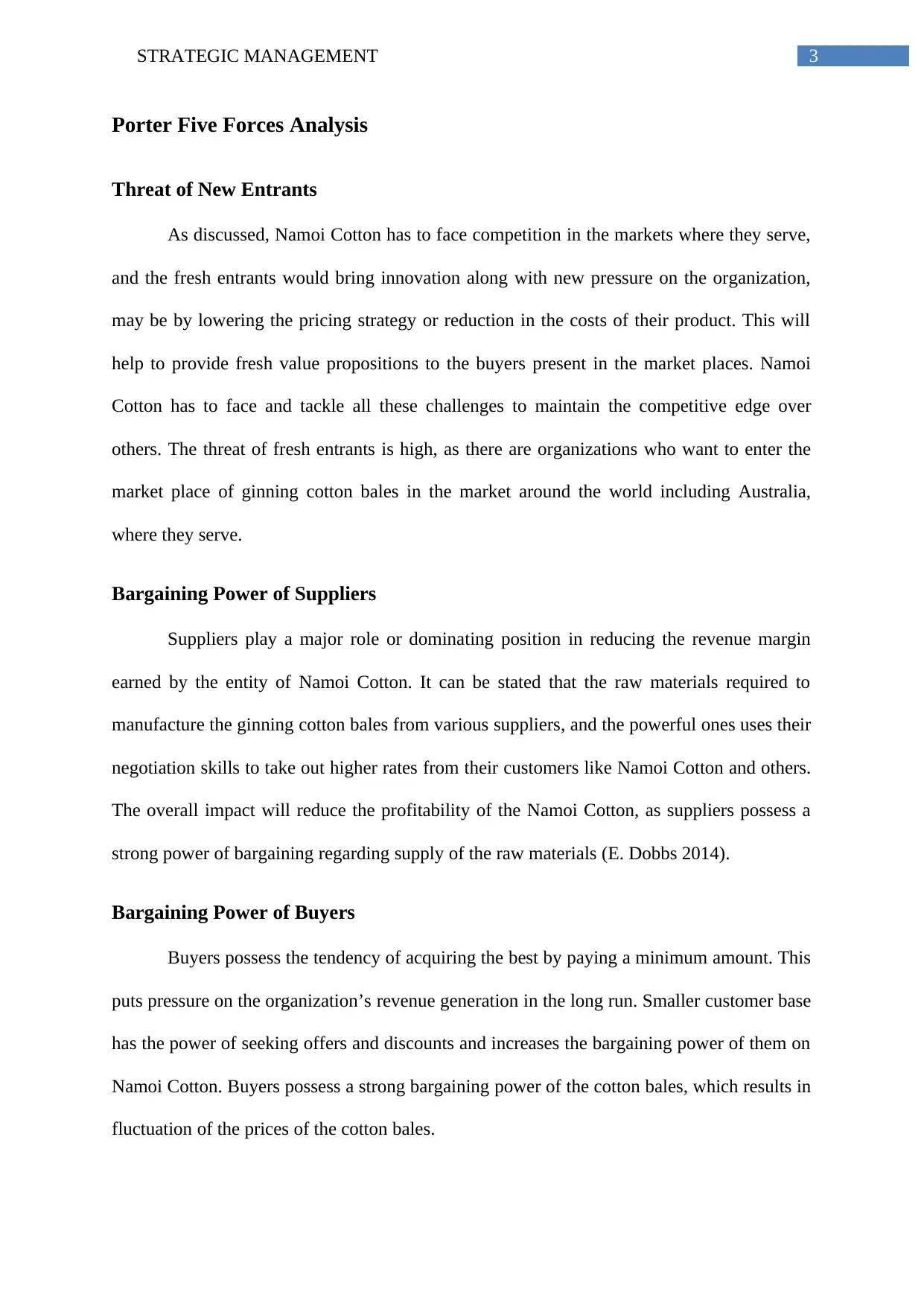
3STRATEGIC MANAGEMENT
Porter Five Forces Analysis
Threat of New Entrants
As discussed, Namoi Cotton has to face competition in the markets where they serve,
and the fresh entrants would bring innovation along with new pressure on the organization,
may be by lowering the pricing strategy or reduction in the costs of their product. This will
help to provide fresh value propositions to the buyers present in the market places. Namoi
Cotton has to face and tackle all these challenges to maintain the competitive edge over
others. The threat of fresh entrants is high, as there are organizations who want to enter the
market place of ginning cotton bales in the market around the world including Australia,
where they serve.
Bargaining Power of Suppliers
Suppliers play a major role or dominating position in reducing the revenue margin
earned by the entity of Namoi Cotton. It can be stated that the raw materials required to
manufacture the ginning cotton bales from various suppliers, and the powerful ones uses their
negotiation skills to take out higher rates from their customers like Namoi Cotton and others.
The overall impact will reduce the profitability of the Namoi Cotton, as suppliers possess a
strong power of bargaining regarding supply of the raw materials (E. Dobbs 2014).
Bargaining Power of Buyers
Buyers possess the tendency of acquiring the best by paying a minimum amount. This
puts pressure on the organization’s revenue generation in the long run. Smaller customer base
has the power of seeking offers and discounts and increases the bargaining power of them on
Namoi Cotton. Buyers possess a strong bargaining power of the cotton bales, which results in
fluctuation of the prices of the cotton bales.
Porter Five Forces Analysis
Threat of New Entrants
As discussed, Namoi Cotton has to face competition in the markets where they serve,
and the fresh entrants would bring innovation along with new pressure on the organization,
may be by lowering the pricing strategy or reduction in the costs of their product. This will
help to provide fresh value propositions to the buyers present in the market places. Namoi
Cotton has to face and tackle all these challenges to maintain the competitive edge over
others. The threat of fresh entrants is high, as there are organizations who want to enter the
market place of ginning cotton bales in the market around the world including Australia,
where they serve.
Bargaining Power of Suppliers
Suppliers play a major role or dominating position in reducing the revenue margin
earned by the entity of Namoi Cotton. It can be stated that the raw materials required to
manufacture the ginning cotton bales from various suppliers, and the powerful ones uses their
negotiation skills to take out higher rates from their customers like Namoi Cotton and others.
The overall impact will reduce the profitability of the Namoi Cotton, as suppliers possess a
strong power of bargaining regarding supply of the raw materials (E. Dobbs 2014).
Bargaining Power of Buyers
Buyers possess the tendency of acquiring the best by paying a minimum amount. This
puts pressure on the organization’s revenue generation in the long run. Smaller customer base
has the power of seeking offers and discounts and increases the bargaining power of them on
Namoi Cotton. Buyers possess a strong bargaining power of the cotton bales, which results in
fluctuation of the prices of the cotton bales.
Paraphrase This Document
Need a fresh take? Get an instant paraphrase of this document with our AI Paraphraser
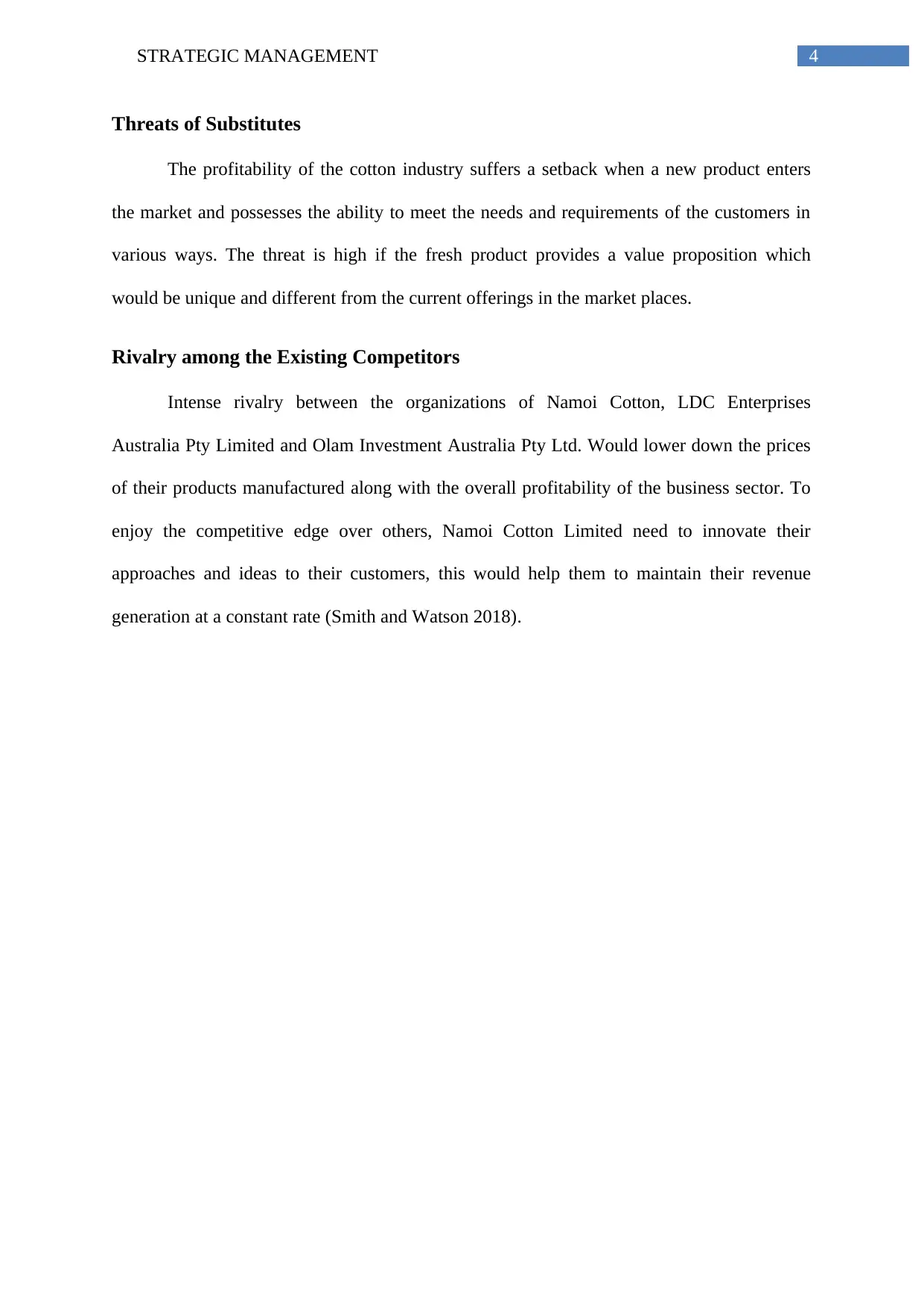
4STRATEGIC MANAGEMENT
Threats of Substitutes
The profitability of the cotton industry suffers a setback when a new product enters
the market and possesses the ability to meet the needs and requirements of the customers in
various ways. The threat is high if the fresh product provides a value proposition which
would be unique and different from the current offerings in the market places.
Rivalry among the Existing Competitors
Intense rivalry between the organizations of Namoi Cotton, LDC Enterprises
Australia Pty Limited and Olam Investment Australia Pty Ltd. Would lower down the prices
of their products manufactured along with the overall profitability of the business sector. To
enjoy the competitive edge over others, Namoi Cotton Limited need to innovate their
approaches and ideas to their customers, this would help them to maintain their revenue
generation at a constant rate (Smith and Watson 2018).
Threats of Substitutes
The profitability of the cotton industry suffers a setback when a new product enters
the market and possesses the ability to meet the needs and requirements of the customers in
various ways. The threat is high if the fresh product provides a value proposition which
would be unique and different from the current offerings in the market places.
Rivalry among the Existing Competitors
Intense rivalry between the organizations of Namoi Cotton, LDC Enterprises
Australia Pty Limited and Olam Investment Australia Pty Ltd. Would lower down the prices
of their products manufactured along with the overall profitability of the business sector. To
enjoy the competitive edge over others, Namoi Cotton Limited need to innovate their
approaches and ideas to their customers, this would help them to maintain their revenue
generation at a constant rate (Smith and Watson 2018).
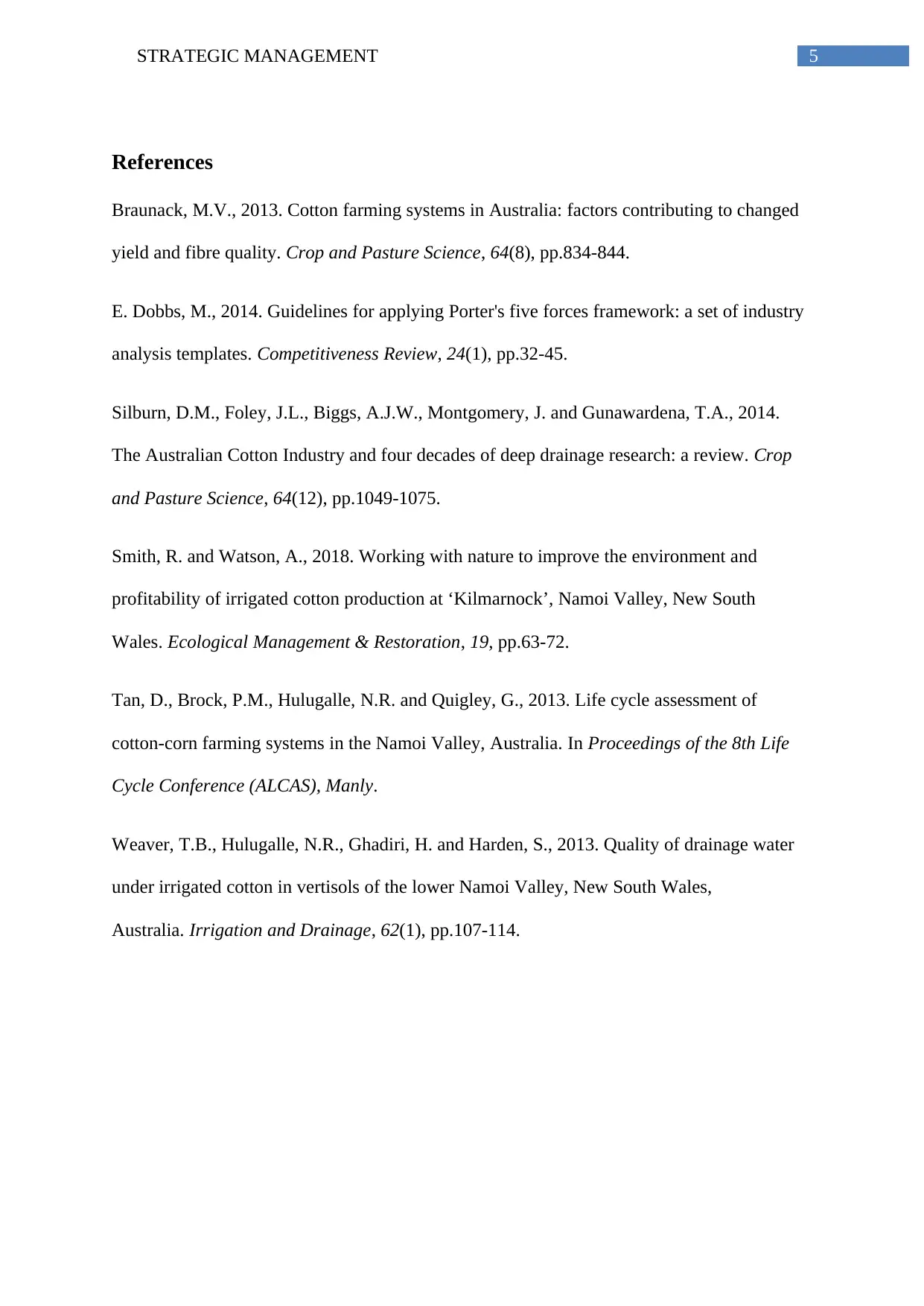
5STRATEGIC MANAGEMENT
References
Braunack, M.V., 2013. Cotton farming systems in Australia: factors contributing to changed
yield and fibre quality. Crop and Pasture Science, 64(8), pp.834-844.
E. Dobbs, M., 2014. Guidelines for applying Porter's five forces framework: a set of industry
analysis templates. Competitiveness Review, 24(1), pp.32-45.
Silburn, D.M., Foley, J.L., Biggs, A.J.W., Montgomery, J. and Gunawardena, T.A., 2014.
The Australian Cotton Industry and four decades of deep drainage research: a review. Crop
and Pasture Science, 64(12), pp.1049-1075.
Smith, R. and Watson, A., 2018. Working with nature to improve the environment and
profitability of irrigated cotton production at ‘Kilmarnock’, Namoi Valley, New South
Wales. Ecological Management & Restoration, 19, pp.63-72.
Tan, D., Brock, P.M., Hulugalle, N.R. and Quigley, G., 2013. Life cycle assessment of
cotton-corn farming systems in the Namoi Valley, Australia. In Proceedings of the 8th Life
Cycle Conference (ALCAS), Manly.
Weaver, T.B., Hulugalle, N.R., Ghadiri, H. and Harden, S., 2013. Quality of drainage water
under irrigated cotton in vertisols of the lower Namoi Valley, New South Wales,
Australia. Irrigation and Drainage, 62(1), pp.107-114.
References
Braunack, M.V., 2013. Cotton farming systems in Australia: factors contributing to changed
yield and fibre quality. Crop and Pasture Science, 64(8), pp.834-844.
E. Dobbs, M., 2014. Guidelines for applying Porter's five forces framework: a set of industry
analysis templates. Competitiveness Review, 24(1), pp.32-45.
Silburn, D.M., Foley, J.L., Biggs, A.J.W., Montgomery, J. and Gunawardena, T.A., 2014.
The Australian Cotton Industry and four decades of deep drainage research: a review. Crop
and Pasture Science, 64(12), pp.1049-1075.
Smith, R. and Watson, A., 2018. Working with nature to improve the environment and
profitability of irrigated cotton production at ‘Kilmarnock’, Namoi Valley, New South
Wales. Ecological Management & Restoration, 19, pp.63-72.
Tan, D., Brock, P.M., Hulugalle, N.R. and Quigley, G., 2013. Life cycle assessment of
cotton-corn farming systems in the Namoi Valley, Australia. In Proceedings of the 8th Life
Cycle Conference (ALCAS), Manly.
Weaver, T.B., Hulugalle, N.R., Ghadiri, H. and Harden, S., 2013. Quality of drainage water
under irrigated cotton in vertisols of the lower Namoi Valley, New South Wales,
Australia. Irrigation and Drainage, 62(1), pp.107-114.
⊘ This is a preview!⊘
Do you want full access?
Subscribe today to unlock all pages.

Trusted by 1+ million students worldwide
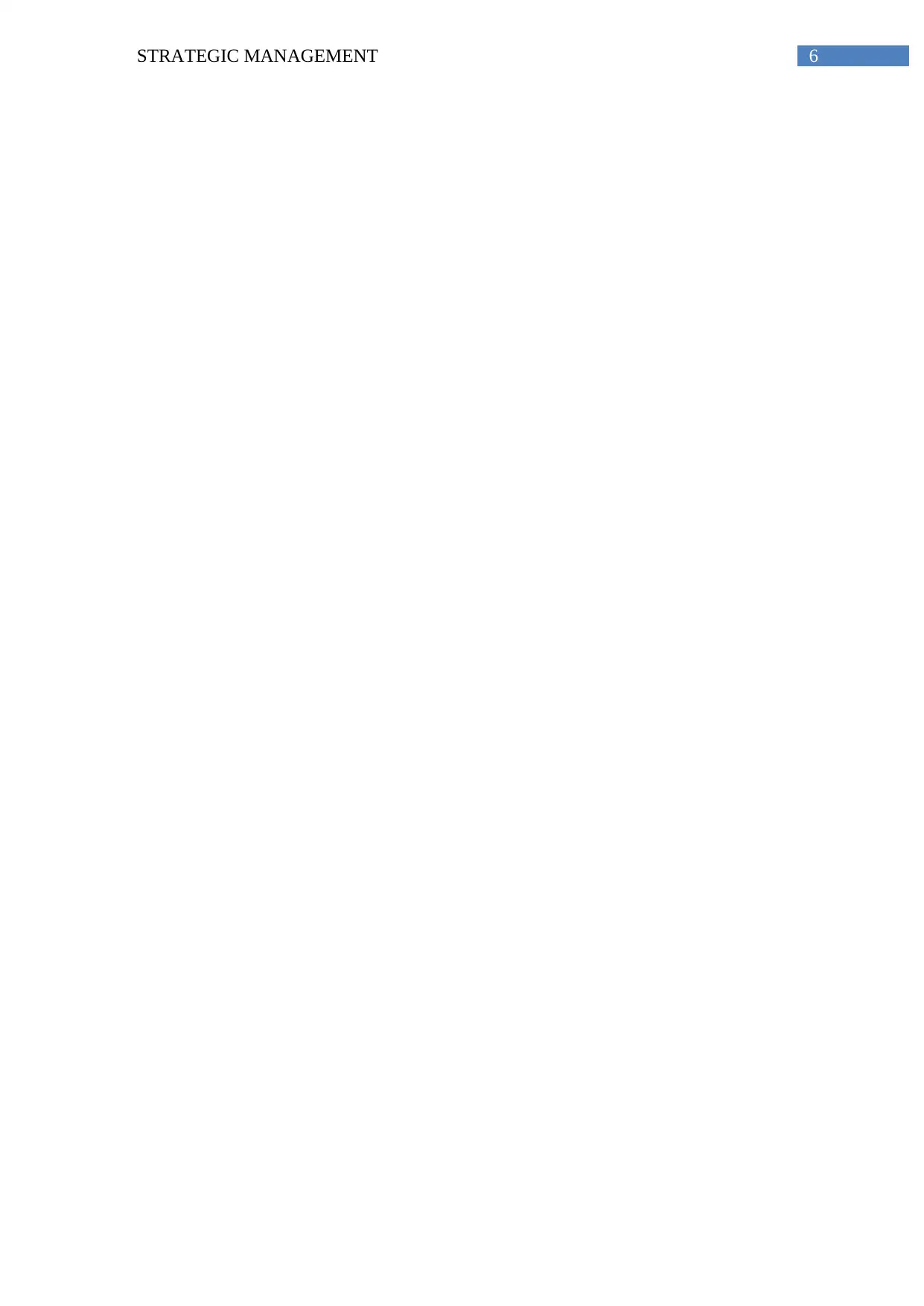
6STRATEGIC MANAGEMENT
1 out of 7
Your All-in-One AI-Powered Toolkit for Academic Success.
+13062052269
info@desklib.com
Available 24*7 on WhatsApp / Email
![[object Object]](/_next/static/media/star-bottom.7253800d.svg)
Unlock your academic potential
Copyright © 2020–2025 A2Z Services. All Rights Reserved. Developed and managed by ZUCOL.
